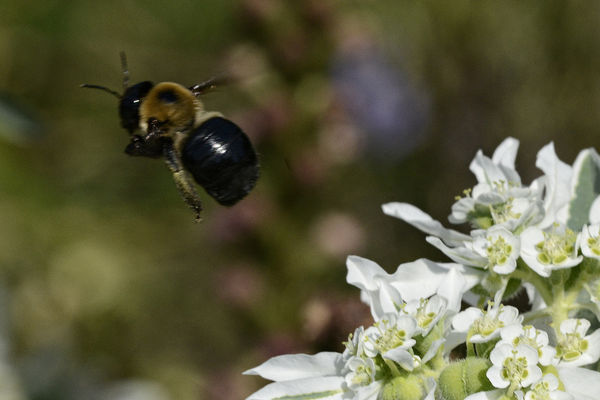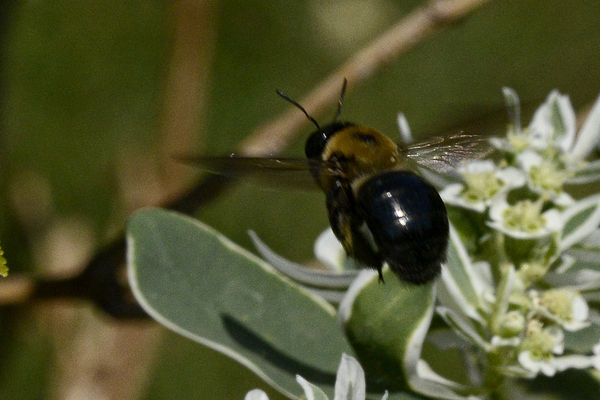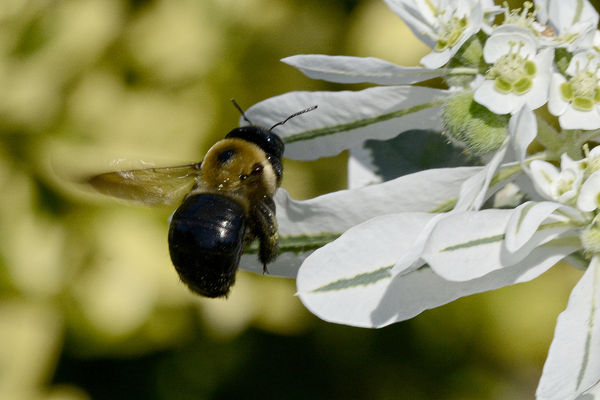Flying Bees
Aug 19, 2013 12:05:48 #
Bugfan
Loc: Toronto, Canada
Greetings All ...
A friend pointed me to this web site so I began to explore a little. I came across a thread that asked for flying bees. So here you are, some flying bees. If anyone is interested I can explain how these are done.
Do have a super day
A friend pointed me to this web site so I began to explore a little. I came across a thread that asked for flying bees. So here you are, some flying bees. If anyone is interested I can explain how these are done.
Do have a super day



Aug 20, 2013 10:00:13 #
Aug 20, 2013 10:29:06 #
Bugfan
Loc: Toronto, Canada
Ok. Here we go ...
Set your camera to continuous focus. Set your meter and your focus to spot. You want only your subject exposed properly and that's all you want in focus too.
Set your focus points to nine points rather than the entire view finder. The processor in the camera may not be fast enough to process more then nine points in continuous shooting. Set your shutter to continuous high speed.
Use Programmed Auto mode unless you are obsessed with depth of field (which happens in macro of course) in which case use Aperture preferred. In either case make sure that your shutter speed is relatively high for the lens you are using. You may have to boost your ISO even at high noon.
Finally use the longest lens you have that gets you macro. For the bees I use a 200 mm macro but I have good success with my 105mm macro as well. If you don't have either of these, a long lens with one or two close up lenses on the front or a few extension tubes at the back will have the same effect. The idea is to get as close to your subject as you can. Ideally you want to be about twelve to eighteen inches away from your subject.
So that's the technical stuff.
Now ... find yourself a nice huge fat bumble bee feeding on a flower. Depress your shutter half way to focus and get your exposure. Make sure you meter and your focus point is on the subject.
Now press the shutter all the way down and wait. In time you'll learn how to anticipate when the bee takes off. Until then just firing off images constantly will capture it in the air eventually. Once its airborne track it as it flies.
Beyond that practice. Eventually you'll know when it's ready to fly and you'll be able to track it more too. Practice with huge fat bumble bees, they're the slowest flyers. Once you start to consistently capture the bees you'll be in a position to go for faster flyers like the hover flies and the hornets and wasps.
I know in print this is really simple and in practice you'll want to have me committed for misleading you. But it does get simpler eventually as you practice. It took me years to develop this technique and then master it but for me now I consistently capture flying insects on demand and you will too.
If you have questions you're welcome to write me back.
I hope this helps a little. God Luck!
Set your camera to continuous focus. Set your meter and your focus to spot. You want only your subject exposed properly and that's all you want in focus too.
Set your focus points to nine points rather than the entire view finder. The processor in the camera may not be fast enough to process more then nine points in continuous shooting. Set your shutter to continuous high speed.
Use Programmed Auto mode unless you are obsessed with depth of field (which happens in macro of course) in which case use Aperture preferred. In either case make sure that your shutter speed is relatively high for the lens you are using. You may have to boost your ISO even at high noon.
Finally use the longest lens you have that gets you macro. For the bees I use a 200 mm macro but I have good success with my 105mm macro as well. If you don't have either of these, a long lens with one or two close up lenses on the front or a few extension tubes at the back will have the same effect. The idea is to get as close to your subject as you can. Ideally you want to be about twelve to eighteen inches away from your subject.
So that's the technical stuff.
Now ... find yourself a nice huge fat bumble bee feeding on a flower. Depress your shutter half way to focus and get your exposure. Make sure you meter and your focus point is on the subject.
Now press the shutter all the way down and wait. In time you'll learn how to anticipate when the bee takes off. Until then just firing off images constantly will capture it in the air eventually. Once its airborne track it as it flies.
Beyond that practice. Eventually you'll know when it's ready to fly and you'll be able to track it more too. Practice with huge fat bumble bees, they're the slowest flyers. Once you start to consistently capture the bees you'll be in a position to go for faster flyers like the hover flies and the hornets and wasps.
I know in print this is really simple and in practice you'll want to have me committed for misleading you. But it does get simpler eventually as you practice. It took me years to develop this technique and then master it but for me now I consistently capture flying insects on demand and you will too.
If you have questions you're welcome to write me back.
I hope this helps a little. God Luck!
Aug 20, 2013 13:47:39 #
Thank you so much I'm gonna do this. I have some nice ones of them on a flower but not flying.
Aug 20, 2013 15:05:31 #
Bugfan
Loc: Toronto, Canada
Hi Natalie ...
Let me just explain the theory behind the advice I gave you.
Setting the camera to continuous focus means that as you're operating at top speed the camera will continue to acquire focus giving most of your images a sharp result. Exposure will also continue to be measured and adjusted for.
The real challenge is keeping the focus spot on the subject and keeping the spot meter there too. I set my SLR to a long delay between changing subjects, this way the camera doesn't refocus on something else every time I lose my subject for a second or two. Instead it waits for me to point to the subject again. But of course that's not fool proof.
The idea behind continuous shooting is simple. Even when you know how to predict when the bee is going to take off, there's no way you can respond fast enough. By shooting continuously however it doesn't matter. And once the bee is airborne you have a chance to track it.
I find too the farther back you can be the easier it is to track the insect. With my 200 mm macro I'm often a good eighteen inches back which makes tracking easier.
Be prepared to take thousands of pictures as well. When I started this technique and worked the bugs out of it I found myself doing a thousand images a day from which I'd get maybe two to ten good ones when I was lucky. Now I do hundreds of images in a day and I get thirty to fifty good ones. And I'm actually still getting better too. It depends only on the speed with which the insects fly.
So those are a few things to think about as you give it a try.
Good Luck!
Let me just explain the theory behind the advice I gave you.
Setting the camera to continuous focus means that as you're operating at top speed the camera will continue to acquire focus giving most of your images a sharp result. Exposure will also continue to be measured and adjusted for.
The real challenge is keeping the focus spot on the subject and keeping the spot meter there too. I set my SLR to a long delay between changing subjects, this way the camera doesn't refocus on something else every time I lose my subject for a second or two. Instead it waits for me to point to the subject again. But of course that's not fool proof.
The idea behind continuous shooting is simple. Even when you know how to predict when the bee is going to take off, there's no way you can respond fast enough. By shooting continuously however it doesn't matter. And once the bee is airborne you have a chance to track it.
I find too the farther back you can be the easier it is to track the insect. With my 200 mm macro I'm often a good eighteen inches back which makes tracking easier.
Be prepared to take thousands of pictures as well. When I started this technique and worked the bugs out of it I found myself doing a thousand images a day from which I'd get maybe two to ten good ones when I was lucky. Now I do hundreds of images in a day and I get thirty to fifty good ones. And I'm actually still getting better too. It depends only on the speed with which the insects fly.
So those are a few things to think about as you give it a try.
Good Luck!
Aug 20, 2013 15:28:59 #
I use manual focus...just seems to do much better than any AF system Iv'e ever used.
Aug 20, 2013 19:38:41 #
If you want to reply, then register here. Registration is free and your account is created instantly, so you can post right away.

